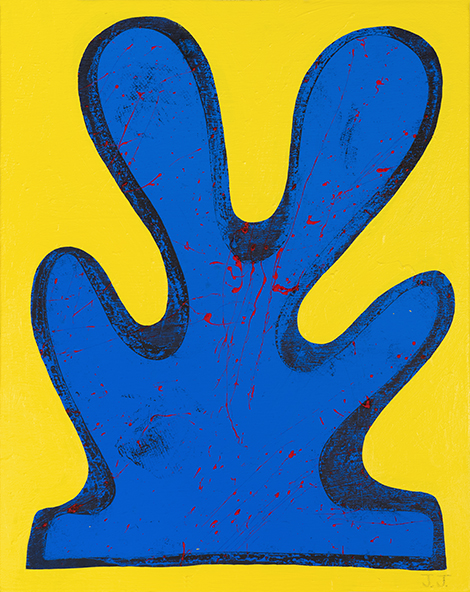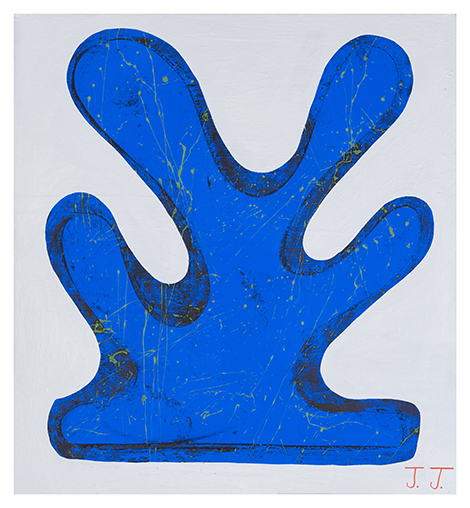Human beings are genetically programmed to respond positively to the face, no doubt a survival instinct, as babies bond with their nurturing parents. Perhaps not coincidentally a fairly recent dad himself, Boston-based Josh Jefferson has tapped into this universal attraction, with an exhibition titled “Head Into The Trees” at Gallery 16.
Having taken up painting a mere three years ago, his work has been gaining momentum in the art world, and notably has been getting a boost from his social-media presence. Also a noted avant-garde jazz saxophonist, Jefferson takes the notion of “portraiture” as a point of departure for a variety of unusual works on paper and canvas in which simplified faces, heads and botanical organisms mesh and morph into one another. An abstracted, rather amoeba-like tree shape recurs in many of the works including the trio Little Blue Tree (2015), Blue Tree (2015) and Tree #5 (2015) hanging together on one wall. In Little Blue Tree, the cobalt form stands out on a brilliant gold background; Jefferson, one may learn, is actually largely color-blind, and these dramatic chromatic shifts work well for him because he can see them clearly, whereas ones with more subtle variations in hue may evade his range of color perception—pink, apparently, appearing gray, or vice versa.
Along the adjacent wall are four paintings on black backgrounds, in which the “tree” form meshes with a head. Hair Tree Top (2015), a smaller work, has a roughly half-circular base in sea-foam green marked with gray, black, red and blue; the top is a blob-like crimson red form overlaid with wide brushy strokes in electric blue, suggesting hair. Depicting heads, a dozen small collages and mixed-media works on paper hang nearby in two rows of six. These feel more contemplative and have greater compositional complexity than the paintings. Untitled Head #4 (2014) uses crayons, ink and gouache on vintage paper. The nose and mouth of this head are formed by a dull green shape suggesting a frog. With rudimentary indications of features and loose interpretations of anatomy, Jefferson draws from the Cubist tradition, along with art of so-called “primitive” cultures that inspired it, as well as a childlike, cartoon-related aesthetic more closely akin to Philip Guston and his many disciples.
Jefferson’s studio practice is one of prolific creation, often including the recycling of earlier works as collage elements, with the editing process taking place later on. He is drawn to work which appears effortless, and this attraction to ease of execution and an unfiltered, deliberate process of mark-making is clearly felt. With tens of thousands of Instagram followers, his boldly graphic and accessible work clearly appeals to a broad range of people. Whether pulled by our collective responsiveness to human physiognomy, or by their often bright, attractive colors, these quirky works have a definite appeal. At the same time, provocative questions of how social media increasingly shapes and informs our perceptions of contemporary culture also emerge.



